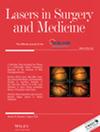Treatment of hypopigmented burn hypertrophic scars with short-term topical tacrolimus does not lead to repigmentation
Abstract
Objectives
Dyschromia is an understudied aspect of hypertrophic scar (HTS). The use of topical tacrolimus has successfully shown repigmentation in vitiligo patients through promotion of melanogenesis and melanocyte proliferation. It was hypothesized that HTSs treated with topical tacrolimus would have increased repigmentation compared to controls.
Methodology
Full-thickness burns in red Duroc pigs were either treated with excision and meshed split-thickness skin grafting or excision and no grafting, and these wounds formed hypopigmented HTSs (n = 8). Half of the scars had 0.1% tacrolimus ointment applied to the scar twice a day for 21 days, while controls had no treatment. Further, each scar was bisected with half incurring fractional ablative CO2 laser treatment before topical tacrolimus application to induce laser-assisted drug delivery (LADD). Pigmentation was evaluated using a noninvasive probe to measure melanin index (MI) at Days 0 (pretreatment), 7, 14, and 21. At each timepoint, punch biopsies were obtained and fixed in formalin or were incubated in dispase. The formalin-fixed biopsies were used to evaluate melanin levels by H&E staining. The biopsies incubated in dispase were used to obtain epidermal sheets. The ESs were then flash frozen and RNA was isolated from them and used in quantitative reverse transcription polymerase chain reaction for melanogenesis-related genes: Tyrosinase (TYR), TYR-related protein-1 (TYRP1), and dopachrome tautomerase (DCT). Analysis of variance test with Šídák's multiple comparisons test was used to compare groups.
Results
Over time, within the grafted HTS and the NS group, there were no significant changes in MI, except for Week 3 in the −Tacro group. (+Tacro HTS= pre = 685.1 ± 42.0, w1 = 741.0 ± 54.16, w2 = 750.8 ± 59.0, w3 = 760.9 ± 49.8) (−Tacro HTS= pre = 700.4 ± 54.3, w1 = 722.3 ± 50.7, w2 = 739.6 ± 53.2, w3 = 722.7 ± 50.5). Over time, within the ungrafted HTS and the NS group, there were no significant changes in MI. (+Tacro HTS= pre = 644.9 ± 6.9, w1 = 661.6 ± 3.3, w2 = 650.3 ± 6.2, w3 = 636.3 ± 7.4) (−Tacro HTS= pre = 696.8 ± 8.0, w1 = 695.8 ± 12.3, w2 = 678.9 ± 14.0, w3 = 731.2 ± 50.3). LADD did not lead to any differential change in pigmentation compared to the non-LADD group. There was no evidence of increased melanogenesis within the tissue punch biopsies at any timepoint. There were no changes in TYR, TYRP1, or DCT gene expression after treatment.
Conclusion
Hypopigmented HTSs treated with 0.1% tacrolimus ointment with or without LADD did not show significantly increased repigmentation. This study was limited by a shorter treatment interval than what is known to be required in vitiligo patients for repigmentation. The use of noninvasive, topical treatments to promote repigmentation are an appealing strategy to relieve morbidity associated with dyschromic burn scars and requires further investigation.

 求助内容:
求助内容: 应助结果提醒方式:
应助结果提醒方式:


